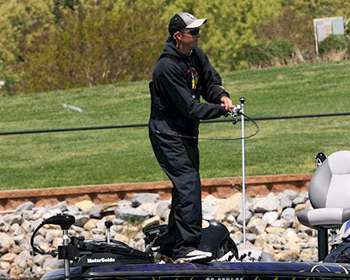
Big baits are nothing new in bass fishing — 8-inch swimbaits, 12-inch plastic worms and big crankbaits are now commonplace in both professional and recreational anglers' tackleboxes across the country. But when it comes to topwaters, the biggest lure in the tacklebox is often a 5-inch Zara Spook.
That's a mistake, according to Elite Series pro Marty Robinson. Living in South Carolina, Robinson is within driving distance of numerous clear-water lakes where 8- to 10-inch blueback herring are the dominant forage for largemouth bass. While smaller topwater offerings generate strikes, Pencil Poppers ranging from 6 to 8 inches in length often outperform their smaller cousins.
"The Pencil Popper is one of the best imitators of a blueback herring," says Robinson. "I've seen herring on the surface that are wounded and they skitter around just like the bait. It has the potential to draw big bass from a long way away."
With a popper head, long body and deep belly, the Pencil Popper creates quite a commotion as it sputters and walks side-to-side across the surface. With a deep rattle, the bait also generates a lot of noise — an important factor for success in choppy water. "I use it more during windy days when it's overcast and the weather is really nasty," says Robinson. "With traditional topwater baits, the fish have a hard time seeing it on the surface.
The more erratic you can make the bait move, the farther you can draw fish in." He says there are times when a Pencil Popper has drawn bass from as deep as 15 feet down. "They'll really focus on the bait and come a long way to get it," he says. "It's just an ideal imitation of a blueback herring, and it will draw a big bite." While Robinson uses the bait in lakes where bluebacks are the primary forage, he says that it is just as effective on lakes where big gizzard shad or other baitfish are present, like Lake Guntersville in Alabama and Lake Amistad in Texas.
"I've had some really good days throwing a Pencil Popper on clear-water lakes like Amistad. It's just a great way to catch a lot of big fish under the right conditions." Originally designed for striped bass, the Pencil Popper is a weighty offering, so Robinson suggests using a long rod with plenty of backbone. He lets the fish determine how he works the bait.
While the offering shines in choppy water, in calmer conditions, he twitches the bait on the surface, using the cupped mouth to spit and spray water. "Regardless of whether you're trying to imitate a blueback herring or a big gizzard shad, the Pencil Popper imitates the big baitfish forage better than any other bait," he concludes.
(Provided by Z3 Media)




